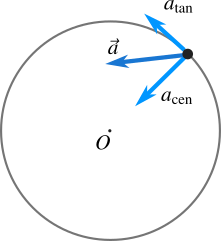In straight line motion we draw a xy-plane with x and y-axis and consider the motion of a particle along x or y-axis. Similarly here in angular motion of a particle we consider a particle moving in a circle but this time the circle is parallel to the xy-plane (i.e. the circle lies on the plane ) and remains perpendicular to z-axis.
What is angular position?
We consider one diameter of the circle along x-axis and another diameter along y-axis such that both diameters are perpendicular to each other as in Figure 1 where z-axis is towards you (you are reading this on either a computer screen or a smartphone).


In Figure 1 a particle of mass \(m\) is moving with velocity \(\vec v\) at point \(p\). Before going into the details of angular motion we should make a distinction between positive and negative rotation. See in Figure 2 and Figure 3 that a particle is moving in a circle of radius \(r\).

The clockwise rotation is negative and the anti-clockwise rotation is positive. In Figure 2 the particle is moving in anti-clockwise direction and so both the angles \(\theta_1\) and \(\theta_2\) are positive (measured in anti-clockwise direction) and the difference \(\Delta \theta\) is also positive but in Figure 3 the particle is moving in clockwise direction and the angles measured in this direction are \(-\theta_1\) and \(-\theta_2\) which are negative.
Here you may have noticed that the position of the particle is measured by the angle made by the line joining the particle and the origin called angular position or angular displacement. In angular displacement the angle has either clockwise or anticlockwise direction but if we say angular distance, we neglect angular direction and focus on the magnitude only.
What is angular velocity?
As in linear velocity which was the rate of change of linear displacement, the angular velocity is the rate of change of angular displacement.
When we simply say angular velocity or linear velocity we mean instantaneous velocity not average velocity. For example if \(\theta_1\) is a angular displacement at time \(t_1\) and \(\theta_2\) is the angular displacement at time \(t_2\) the average angular velocity is the change in angular displacement divided by the time interval \(\Delta t = t_2 - t_1\).
\[{\omega _{av}} = \frac{{{\theta _2} - {\theta _1}}}{{{t_2} - {t_1}}} = \frac{{\Delta \theta }}{{\Delta t}} \tag{1} \label{1}\]
Angular velocity is denoted by the Greek letter "\(\omega\)" called omega. The instantaneous angular velocity is the velocity when the time interval \(\Delta t\) approaches zero.
\[{\omega _{{\rm{ins}}}} = \mathop {\lim }\limits_{\Delta t \to 0} \frac{{\Delta \theta }}{{\Delta t}} = \frac{{d \theta }}{{dt}} \tag{2} \label{2}\]
In figures Figure 2 and Figure 3 the circle along which the particle moves lies on the xy-plane perpendicular to z-axis. The z-axis is not shown in Figure 2 and Figure 3 which is perpendicular to the xy-plane and passes through the origin.
The direction of angular velocity is determined by the right hand rule- curl the fingers of your right hand in the direction of rotation leaving the thumb straight along the axis (in our case z-axis) perpendicular the plane of rotation (in our case xy-plane) and the thumb gives the direction.
If the particle is moving in anticlockwise direction, you should curl your fingers of right hand in anticlockwise direction leaving the thumb straight (in our case the thumb should be along z-axis) and the thumb gives the direction of angular velocity.
What is angular acceleration?
Similar to what I did for linear case I define average and instantaneous angular acceleration. Let the angular velocity at time \(t_1\) be \(\omega_1\) and at time \(t_2\) be \(\omega_2\). So the average angular acceleration \(\alpha _\text{av}\) is the change in angular velocity divided by the time interval \(\Delta t = t_2 - t_1\) which is,
\[{\alpha _{{\rm{av}}}} = \frac{{{{\omega }_2} - {{\omega }_1}}}{{{t_2} - {t_1}}} = \frac{{\Delta \omega }}{{\Delta t}} \tag{3} \label{3}\]
The instantaneous angular velocity is straightforward as before, that is when \(\Delta t\) approaches zero:
\[{\alpha _{{\rm{ins}}}} = \alpha = \mathop {\lim }\limits_{\Delta t \to 0} \frac{{\Delta \omega }}{{\Delta t}} = \frac{{d \omega }}{{dt}} \tag{4} \label{4} \]
The angular acceleration is denoted by \(\alpha\). Remember that if we simply say angular acceleration, we mean instantaneous angular acceleration not average angular acceleration. You can find the direction of angular velocity by the right hand thumb rule but to find the direction of angular acceleration you can not use it- of course you can use it to find the direction of angular velocity. That's because you need to consider the difference of angular velocities.
If the particle's linear speed increases (in clockwise or anticlockwise direction), the angular velocity and acceleration both lie in the same direction but on the other hand if the particle's linear speed decreases, the angular velocity and acceleration lie in opposite directions.
One easy idea to remember the direction of angular acceleration is that first find the direction of angular velocity by the right hand thumb rule and check whether the particle is speeding up or slowing down.
If you find the particle is speeding up, the direction of angular acceleration will be the same as the direction of angular velocity but if you find the particle is slowing down, the direction of angular acceleration will be opposite to the direction of angular velocity. Another important thing you should remember is the speed is always a positive quantity and it doesn't matter what the direction of motion is.
Linear and Angular Speeds
As said above the speed is a positive quantity- it can't be negative. Here we derive an expression that connects linear speed of a particle rotating about a point with its angular speed.


In Figure 4 an angle \(\theta\) subtends an arc \(\newcommand{arc}[1]{\stackrel{\Large\frown}{#1}}\arc{AB}\) of length \(s\). An angle radian is the ratio of arc length to radius of a circle. It means the angle \(\theta\) is the ratio of the arc length \(s\) to the radius \(r\) of the circle that is, \(\theta = s/r\). The angle is \(1\) radian when the arc length is equal to the radius of the circle that is, when \(s = r\), \(\theta = s/r = 1\). The angle radian is a dimensionless quantity as it is the ratio of two lengths. So,
\[s = r\theta \tag{5} \label{5}\]
We can differentiate both sides of Eq. \eqref{5} with respect to \(t\) as \(\frac{{ds}}{{dt}} = r\frac{{d\theta }}{{dt}}\) and the linear speed \(v\) is
\[v = r\omega \tag{6} \label{6}\]
The Eq. \eqref{6} represents the linear speed in terms of the angular speed and vice versa. You can also find the centripetal acceleration of a particle of mass \(m\) moving in a circle of radius \(r\) with linear speed \(v\) in terms of angular speed \(\omega\). From Eq. \eqref{6},
\[{a_{{\rm{cen}}}} = \frac{{{v^2}}}{r} = \frac{{{r^2}{\omega ^2}}}{r} = r{\omega ^2} \tag{7} \label{7}\]
You can also use Eq. \eqref{6} to find the tangential component of linear acceleration in terms of angular acceleration. To do so differentiate both sides of Eq. \eqref{6} with respect to \(t\) and you'll get:
\[{a_{\tan }} = r\alpha \tag{8} \label{8}\]
The subscript \(\text{tan}\) is the reminder of tangential and the subscript \(\text{cen}\) is the reminder of centripetal (towards the centre). Figure 5 illustrates both components of acceleration of a particle moving in a circle. And if the tangential component is zero as in uniform circular motion there will be the centripetal acceleration only.





